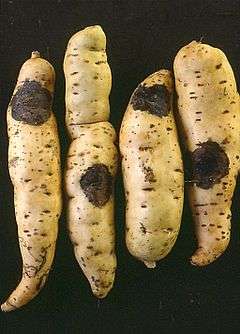Ceratocystis fimbriata
| Ceratocystis fimbriata | |
|---|---|
 | |
| Sweet potato black rot caused by Ceratocystis fimbriata | |
| Scientific classification | |
| Kingdom: | Fungi |
| Division: | Ascomycota |
| Class: | Sordariomycetes |
| Order: | Microascales |
| Family: | Ceratocystidaceae |
| Genus: | Ceratocystis |
| Species: | C. fimbriata |
| Binomial name | |
| Ceratocystis fimbriata Ellis & Halst. (1890) | |
| Synonyms | |
| |
Ceratocystis fimbriata is a fungus and a plant pathogen, attacking such plants as the sweet potato (black rot) and the tapping panels of the Para rubber tree (moldy rot). It is a diverse species that attacks a wide variety of annual and perennial plants. There are several host-specialized strains, some of which, such as Ceratocystis platani that attacks plane trees, are now described as distinct species.
Taxonomy
Ceratocystis fimbriata, the type species of the genus Ceratocystis, was originally described on the sweet potato (Ipomoea batatus) in 1890.[1] It has since been found on a wide variety of annual and perennial plants.[1] It is a large, diverse complex of species that cause wilt-type diseases of many economically important plants.[2] There are thought to be three broad geographic clades, the North American, the Latin American and the Asian clades.[1]
It is thought likely that Ceratocystis fimbriata contains many undescribed, hidden species.[2] One form of the fungus that causes a wilt disease in cacao was in 2005 described as a new species Ceratocystis cacaofunesta.[2] Another form that causes a disease on plane trees (Platanus), and which was previously known as Ceratocystis fimbriata f. platani, was in 2005 elevated to species Ceratocystis platani.[2]
Diseases
Black rot of sweet potato
The Ipomoea form of the fungus that attacks the sweet potato (Ipomoea batatas), is thought likely to be native to Latin America.[1] It has spread to many locations probably on storage roots. The fungus may appear as a dry, black rot, usually with perithecia and ascospores.[1] In some countries (such as China and Japan) it is an important constraint to sweet potato production. In other areas (such as southeastern USA) the damage is less severe due to the use of resistant varieties and sanitary measures.[1] Fungicides can be used in sweet potato fields or as post-harvest dips of sweet potato roots.[1]
Mouldy rot of rubber
On rubber trees (Hevea brasiliensis), C. fimbriata attacks the tapping panel, causing a pale-grey mould on the surface of the panel and dark discoloration in the wood under the surface.[1] Fungicides can be used to treat tapping panels of Hevea.[1]
Wilt and canker of coffee
A fungus attacking Coffea in Indonesia was described as Rostrella coffea in 1900 and this species was synonymized with Ceratocystis fimbriata in 1951.[1] It is widespread in Central America and northern South America, and is a particularly damaging disease in Colombia.[1]
Mango wilt
Mango wilt is known only in Brazil, even though mango trees (Mangifera indica) are grown in other areas where C. fimbriata is common on other plants.[1] Infection typically occurs through fresh wounds on trees although root infections also occur. Infection is often accompanied by secondary attack by various ambrosia beetles.[1]
Ficus wilt
Ficus wilt is a severe disease found in fig trees (Ficus carica) in Brazil.[3] There is also an Asian form of Ficus wilt caused by C. fimbriata found in southern Japan.[3]
Rapid Ohi'a Death
A form of Ceratocystis fimbriata was identified in 2015 as the cause of widespread mortality in Ohi'a trees (Metrosideros polymorpha) in the Puna District on the island of Hawai'i.[4] The source of the outbreak is currently unknown.
In other plants
Many other plants are harmed by C. fimbriata. It has caused serious mortality in Eucalyptus plantations in Brazil as well as in the Congo and Uganda.[1] Almonds (Prunus dulcis) in California have been affected by the disease.[1] It has also caused losses in pomegranates (Punica granatum) in India.[1] It causes a dark, dry rot in Taro tubers.[3]
References
- 1 2 3 4 5 6 7 8 9 10 11 12 13 14 15 16 "Ceratocystis fimbriata". CABI Crop Protection Compendium. CABI Publishing. 2004. Retrieved 20 October 2014.
- 1 2 3 4 Engelbrecht, C. J. B.; Harrington, T. C. (2005). "Intersterility, morphology and taxonomy of Ceratocystis fimbriata on sweet potato, cacao and sycamore". Mycologia 97: 57. doi:10.3852/mycologia.97.1.57.
- 1 2 3 Harrington, Tom. "Diseases Caused by members of the Ceratocystis fimbriata complex". Iowa State University, Department of Plant Pathology. Retrieved 20 October 2014.
- ↑ Friday, JB. "Rapid ʻŌhiʻa Death - Ceratocystis Wilt of ʻŌhiʻa". University of Hawai'i, College of Tropical Agriculture and Human Resources. Retrieved 23 December 2015.
External links
| Wikimedia Commons has media related to Ceratocystis fimbriata. |
Ceratocystis fimbriata in Index Fungorum